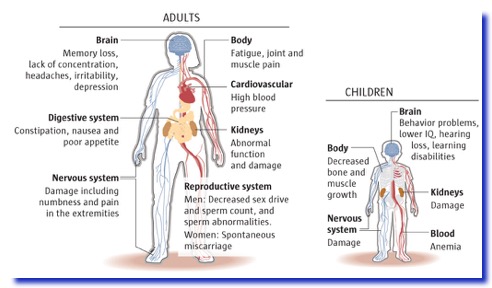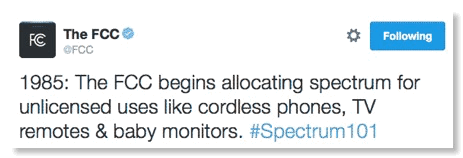FCC's 1980's Flint-like Lead Issue

A reliable source in the Office of the Managing Director, knowing that I was the victim of their bosses' efforts, told me in the mid 1980 that FCC tested the lead levels in water coolers in its various buildings near the corner of 20th and M St., NW and found that the lead levels in the main FCC building at 1919 M St. exceeded a new EPA regulation that would be going into effect.
What did FCC do?
- Provide lead free water to all staff members?
- At least provide it to all pregnant staff members?
- Advise the staff of the issue so they could make their own decisions?

The Office of the Managing Director management swore their staff to secrecy on this issue and proceeded to make repairs to get the lead level down to EPA standards before the new regulations went into effect. Did the Chairman know? Possibly. Did the commissioners know? Probably not.
So you may ask, isn't some level of lead exposure for a small time safe? Here's what EPA says:
This type of cynical attitude towards the FCC staff has been part of FCC's DNA going back decades. While I did not necessarily agree with all of Chmn. Powell's telecom policy positions, he was a welcome breath of fresh air. For example, he restored a reasonable training budget for the FCC staff as a whole, not just a few elite senior staffers and reinstated the master's degree program for Commission engineers that had been unfunded for over two decades.
I suspect because Powell had been a junior military officer and had grown up in a military family he understood the importance of motivating staffers and earning their respect. Most other chairmen in memory came from small organizations and lacked management experience in a 2000 person organization. Typically the chair and commissioners are focused on getting as much done as possible during their terms with little concern about the infrastructure of the organization including its staff. But I must admit that the lead coverup of the 1980s was a new low in FCC mistreatment of its staff.
Foreign Research on Spectrum Frontiers That FCC and NTIA Block Access To

This week Wireless & RF magazine published the above article on terahertz (THz) technology R&D in Japan. While we do not necessarily believe it is now time to sell your Corning stock because fiber optic telecom is doomed, this clearly demonstrates continuing foreign interest in technology that FCC is at best apathetic about and which NTIA has allowed certain IRAC members to discourage.
While the major regulatees who routinely show up on the FCC's 8th Floor have little interest in these frequencies, these same corporations and trade association also showed little interest in Docket 81-413 that ultimately spawned Wi-Fi and Bluetooth and Docket 94-124 that stimulated the R&D that showed the surprising result that mmWave/"spectrum frontier" mobile systems were practical. Thus FCC's mainstream spectrum regulatees can sometimes be myopic and sometimes have "crystal ball" problems.
Lest you think that this article about 275+ GHz technology in Japan is isolated, here is a quote from an ETSI report last year:
“With respect to the aforementioned, the mission of ETSI ISG mWT is to promote the use of millimetre wave spectrum from 50 GHz up to 300 GHz for present and future critical transmission applications and use cases. Moreover, ETSI ISG mWT will focus on enhancing the confidence of all stakeholders and the general public in the use of millimetre wave technologies.”
Here are several other article on foreign R&D above FCC present 95 GHz service rule limit and 275 GHz allocation limit:
- Japanese 120 GHz system used at Beijing Olympics
- Japanese 72-100 GHz components
- Japanese 300 GHz receiver — Note that this article indicates that "A portion of these research results were obtained through 'R&D Program on Multi-tens Gigabit Wireless Communication Technology at Subterahertz Frequencies,' a research program commissioned by Japan's Ministry of Internal Affairs and Communications as part of its 'Research and Development Project for Expansion of Radio Spectrum Resources.' " This confirms direct involvement of the Japanese regulator as part of its "industrial policy" program.
- German 237 GHz outdoor experiment - Note that the authors of this experiment have never revealed the exact upper and lower frequency limits of their transmissions and it is likely that it intruded into a passive allocation. Certain IRAC members routinely try to block such experiments regardless of whether they actually impact passive spectrum use and NTIA has not been assertive in overview of such actions.
FCC is moving ahead on Docket 14-177 on "spectrum frontier" mobile use in 28-71 GHz and that is not an issue here. The problem is that FCC has turned its "blind eye" to all other "spectrum frontier" issues while our foreign competitors are marching full speed ahead.
It gets worse! Google "terahertz spectroscopy" and you will see that there are US made products now being sold above 95 GHz for noncommunications use. A careful parsing of §302a and §2.803 of the FCC Rules reveals that the sale of such equipment is presently legal, however the use of such equipment appears to be a violation of §301 since there are no licensed or unlicensed service rules at these frequencies. The manufacturers of such equipment presently have little concern since EB is easily distracted by other mood swings and is laying off much of its field staff. But sooner or later that will need capital access and will discover what "due diligence" means! Denying such firms capital access will not help US competitiveness. FCC outreach to them will! Do you have to presently be a multibillion dollar industry to get FCC attention? We certainly can recall when Wi-Fi was a tiny industry.
Isn't it time for FCC to pay some attention to upper spectrum especially since 275+GHz allocations are on the WRC-19 agenda?
@FCC Makes Unforced Error on History of Unlicensed

At 12:06 PM on April 1, 2016 the official FCC Twitter account, @FCC, sent out the above tweet as part of "Spectrum101: Great Moments in Spectrum History". It has now been deleted, possibly because I responded to this tweet with the statement that while the unlicensed ISM band that is home to Wi-Fi and Bluetooth (and many other devices) began in May 1985, unlicensed spectrum has been around since 1938 although it is not explicitly authorized in the Communications Act of 1934. Hopefully, some readers here are old enough to remember that cordless phones predate 1985. (If you can't remember this, ask your parents.)
The video below shows the FCC's May 1985 decision and may explain why I remember it so clearly:
Former FCC staffer Kenneth Carter explained the actual history of unlicensed in a 2009 paper titled "Unlicensed to kill: a brief history of the Part 15 rules". Ken wrote:
In 1938, shortly after its founding, the FCC first permitted unlicensed devices to be sold and operated without a license. The Part 15 rules stem from what is possibly an oversight offundamental physical phenomenon by the Communications Act of 1934. Congress had intended to treat the regulation of spectrum in the way in which we traditionally think of it. Namely, the FCC was to award rights through licensing discrete individual entities, including such as radio broadcasters, the military, and the alike. This, however, failed to recognize two facts. First, that nearly all devices that employ electricity leak or reradiate electromagnetic energy, albeit at very low power levels. Second, also at this time, radio device manufacturers started introduce short range, low duty cycle communication devices which operated employing low levels of energy over very short distances[8]. As a result, the FCC set about to promulgate rules to manage such devices based on the jurisprudence that if RF emissions that were sufficiently weak and short ranged so as to not be considered measurable, they would, therefore, not rise to the level of harmful interference. This was explained by then-FCC Chief Engineer, Ewell Jett in 1938:
"What we are concerned with immediately is the problem of interference. If certain low power devices can be used without interfering with radio communications, there would appear to be no engineering reason for suppressing their use. (Footnotes omitted)
What is the difference between 1938 style unlicensed spectrum and post 1985 style? The original unlicensed rules allowed only specific functionality in a specific band requested by a petitioner. This band could be used by cordless phones, this for garage door openers. Always with very low power. Have a new possible use? File a petition and wait!
The Docket 81-413 regime adopted in 1985 set forth some technical requirements and allowed much higher power. It did not restrict the type of use. Thus while the rulemaking never mentioned radio LANs, when they became important in the late 1980s the RLAN proponents used the Docket 81-413 unlicensed regime to get access to the ISM bands quickly without nonroutine FCC action. True "permissionless innovation" before the term was invented!
Another garble in the this short length (and short lived tweet) is the use of "allocating" as the 5th word. All real spectrum wonks know that unlicensed is not an allocation, rather it is a permitted secondary use on an NIB (noninterference basis). Why there were so many garbles in such a short tweet is puzzling and raises questions of FCC as an "expert agency in spectrum".
Or maybe we should have read the date more carefully? However the other "#Spectrum101" tweets the same day seemed correct.
Our fellow bloggers at CommLawBlog on the same day as this tweet had an April Fools post entitled "Looking for Improved Public Image, FCC Reorganizes Office of Media Relations". After reading both the tweet and the CommLawBlog post, it is hard to tell which is real!




![Validate my RSS feed [Valid RSS]](valid-rss-rogers.png)

